EXCLUSIVE ARTICLE |
||
|
||
EXCLUSIVE ARTICLE |
||
|
||
 |
|
||||||||||
|
It soon became clear that Sellers, originally considered a supporting actor, was stealing the film from Niven. The pair would later appear in the spoof James Bond film Casino Royale in 1967, although they shared no scenes, but this time Peter Sellers received top billing. However, by this stage in his career Sellers was becoming so erratic and unmanageable, that he was fired from that production even before his role as Evelyn Tremble was completed. His disappearance from the film half way through made the already disjointed storyline even more confusing. Through clever editing, and use of material already shot but not included in the film, Peter Sellers then reappeared during the end credits of Casino Royale (1967). |
||||||||||
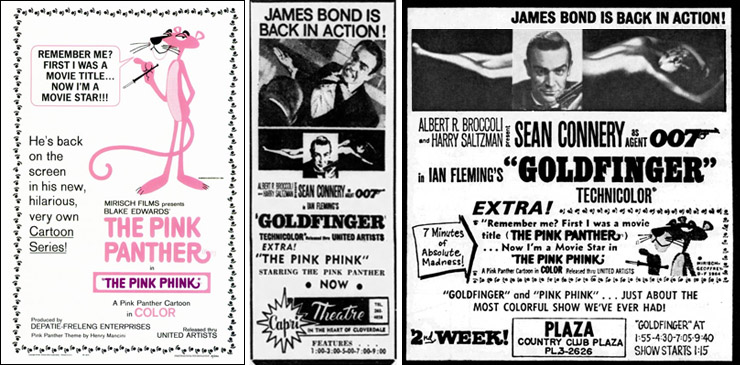 |
||||||||||
|
The Pink Panther was initially released on December 18, 1963 in Italy, followed by a London opening at the ODEON Leicester Square on Thursday January 9, 1964. The film debuted in the United States on March 18, 1964, where it went on to gross over $10-million. The opening title sequence in The Pink Panther was such a success with the public that United Artists executives decided to adapt this into a series of theatrical animated shorts. United Artists commissioned DePatie–Freleng Enterprises, run by former Warner Bros. Cartoons creators David H. DePatie (1929-2021) and Isadore ‘Friz’ Freleng (1905-1995) to create the films. The first of the series, The Pink Phink, won the 1964 Academy Award for Best Animated Short Film. The Pink Phink also supported Goldfinger on its original Christmas 1964 release in the USA and Canada. In total there were 124 Pink Panther animated shorts produced by DePatie–Freleng Enterprises between 1964 and 1978. 92 shorts were released theatrically, with the first 62 entries later appearing on Saturday mornings as part of the NBC television series The Pink Panther Show beginning in 1969. Pink Panther shorts would continue to support the James Bond films (and other United Artists distributed films) throughout the 1960s and 1970s. The premiere of Thunderball at the London Pavilion on December 29, 1965 also had a Pink Panther cartoon shown before the film, although this was replaced by British Movietone News at the Rialto Theatre screening which screened simultaneously. Four Pink Panther cartoons also supported Thunderbird 6 when it played in UK cinemas at afternoon matinee performances over the school holidays in July/August 1968. |
||||||||||
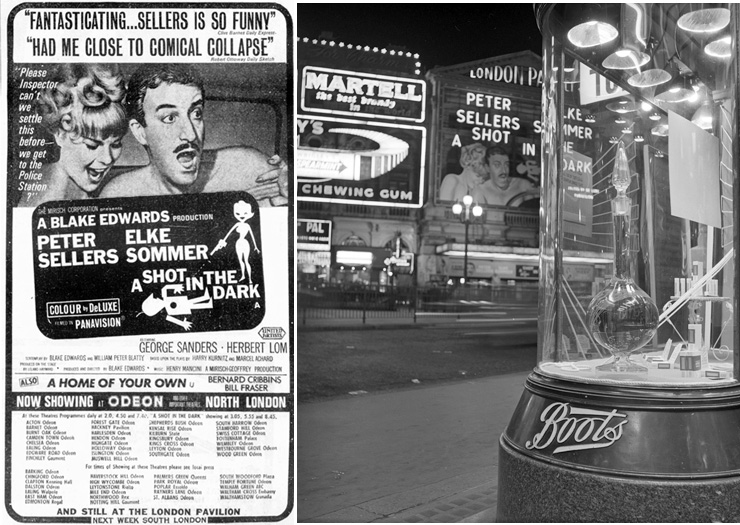 |
||||||||||
|
Following the success of The Pink Panther (1963) a sequel was hurriedly produced this time focussing on the Inspector Clouseau character. A Shot In The Dark was based on the French play L'Idiote by Marcel Achard, and filmed at the MGM Studios in Borehamwood, although the film is set entirely in France. A Shot In The Dark marks the first appearances of Herbert Lom as Clouseau's long-suffering boss, Commissioner Dreyfus; Burt Kwouk as his manservant Cato, and André Maranne as François. All three would become series regulars. The UK based production also explains the casting of many other notable British character actors in supporting roles. Released in the USA on June 23, 1964, A Shot In The Dark would not open in the UK until Thursday January 28, 1965. Playing for three weeks at the ODEON Leicester Square, A Shot In The Dark then transferred to the London Pavilion where it went on to play for a further 12 weeks. Once again distributed worldwide by United Artists, A Shot In The Dark was even more successful than The Pink Panther. The two films were then paired on a successful double-bill in late 1965 on both sides of the Atlantic, with the ODEON Kensington playing host to the UK pre-release engagement for one week from Sunday November 14th. The double-bill then went on general release on the Rank Circuit from Sunday November 21, 1965. |
||||||||||
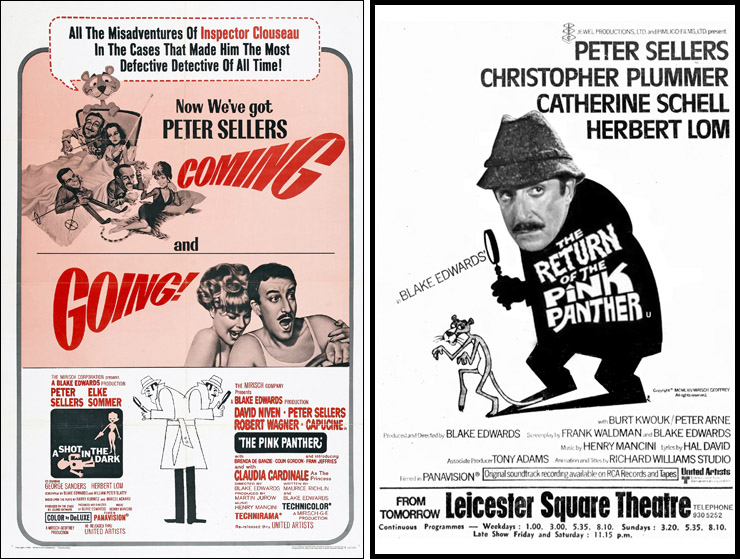 |
||||||||||
|
Despite the huge success of the first two films, director Blake Edwards and star Peter Sellers did not get along and vowed never to work together again. The pair later resolved their differences and eventually made a third film together in 1968. Although very successful, The Party is now viewed as a very politically incorrect so-called comedy, with Sellers made up as a bumbling Indian film star. The Mirisch Corporation had wanted to make a third Pink Panther film, but when Sellers and Edwards turned them down they went ahead anyway and cast American actor Alan Arkin in Inspector Clouseau (1968). Apart from the linking character, there were no connections to the Pink Panther series, other than the animated opening credits created and designed by DePatie-Freleng Enterprises. Directed by Bud Yorkin, Inspector Clouseau was a critical and commercial disaster for distributor United Artists. |
||||||||||
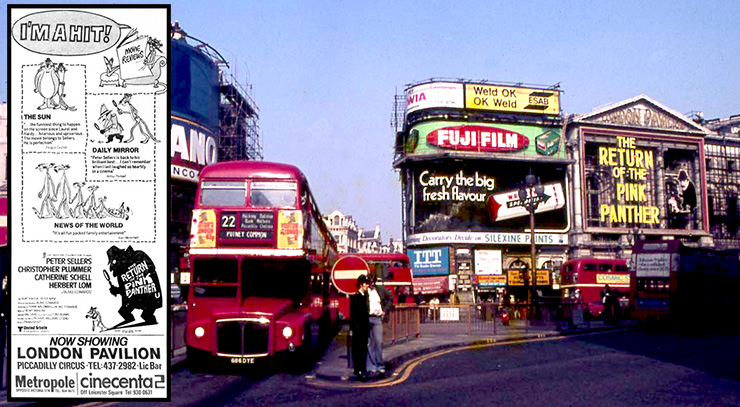 |
||||||||||
|
The franchise lay dormant until 1975 when Blake Edwards and Peter Sellers put aside their differences once again and returned to the series with The Return Of The Pink Panther. Co-starring Christopher Plummer, standing in for David Niven as Sir Charles Lytton (now credited as Litton), and Catherine Schell [Nancy in On Her Majesty's Secret Service (1969)], the film was again produced by The Mirisch Corporation, but the franchises’ distributor and main backer, United Artists, declined to finance the film as they had no interest in working with Blake Edwards or Peter Sellers, whose careers had declined by this point. The Return Of The Pink Panther was therefore financed by British producer Lew Grade's ITC Entertainment. United Artists, convinced the film would be a flop, gave ITC world distribution rights in exchange for a share of the profits. The film turned out to be a massive international hit and consequently one of UA's biggest money makers that year. Budgeted at $5-million, the film went on to take over $75-million at the box-office, and revived the careers and fortunes of all concerned. The Return Of The Pink Panther opened at the 1,407-seat Leicester Square Theatre on January 1, 1976 - where it played until Thursday February 26th. The hugely successful third film in the series then transferred to the London Pavilion on Thursday March 18, 1976 where it played for five weeks. The Return Of The Pink Panther also screened simultaneously at the 2,000-seat Metropole opposite Victoria station for 7-weeks from Thursday February 19, 1976; and also at the 150-seat Cinecenta 2 off Leicester Square for a staggering 20-weeks following its initial Leicester Square Theatre engagement. |
||||||||||
|
||||||||||
|
In the USA The Return Of The Pink Panther was paired with The Spy Who Loved Me in late 1977, and then released on an official double-bill with The Pink Panther Strikes Again in time for the Christmas holiday season on both sides of the Atlantic. The pairing was another huge commercial success and joined United Artists’ string of hits that year; which included A Bridge Too Far and The Spy Who Loved Me, along with re-issues of Carrie (1976) and One Flew Over The Cuckoo's Nest (1975). |
||||||||||
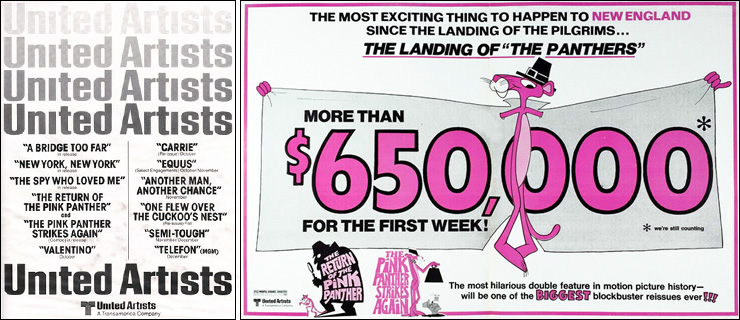 |
||||||||||
|
||||||||||
 |
||||||||||
|
By 1980 United Artists were facing financial disaster due to the costly production of Michael Cimino's epic Western Heaven's Gate. On June 26, 1980, Cimino previewed a work print for United Artists executives that reportedly ran 325-minutes. UA flatly refused to release the film at that length and contemplated firing Cimino, who promised he could re-edit the film, spending the rest of 1980 doing so. Cimino finally reduced the film down to its original premiere length of 219-minutes. The resulting delays caused Heaven's Gate to miss its original Christmas 1979 opening date. Following a brief theatrical release in November 1980, when the film was poorly received by critics, United Artists decided to pull the film from cinemas, re-releasing it in April 1981 in a truncated 149-minute cut. |
||||||||||
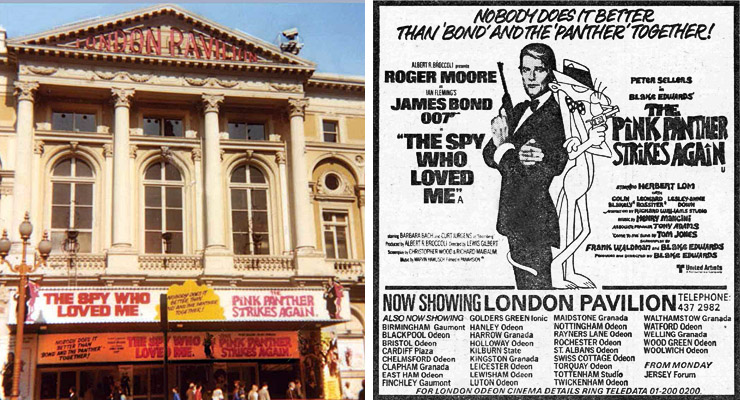 |
||||||||||
|
Whilst United Artists were still having major financial success with their James Bond, Pink Panther, and Rocky franchises, they had also had their share of box-office failures and needed to recoup some of their losses. It therefore made sense to team up two of their biggest hits for another double-bill in the UK. The Spy Who Loved Me/The Pink Panther Strikes Again opened at the London Pavilion on Thursday March 20, 1980 (where the double-bill played for four weeks), and across the UK from Sunday March 23rd. The pair were re-released over the Easter holiday period, but continued to play at many coastal resorts until August/September to take advantage of the school summer holidays. By now the James Bond films were aimed more at a juvenile audience, but this time backed up by a new marketing campaign to exploit the success of two of the studios’ most profitable series. The 1980 double-bill was once again very successful for United Artists, but within a year the studio faced bankruptcy, due largely to the critical and commercial failure of Heaven's Gate. |
||||||||||
 |
||||||||||
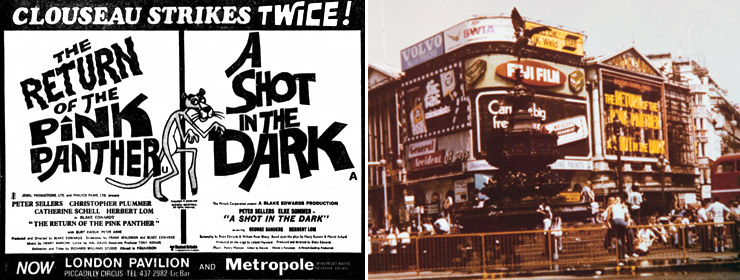 |
||||||||||
|
Like the James Bond series, the Pink Panther films were re-issued many times on double-bills which further added to their box-office success throughout the 1970s. Despite their initial reservations about The Return Of The Pink Panther, distributor United Artists then paired the 1975 hit with every other Sellers/Clouseau entry in the series, and it went on to become one of the highest-grossing comedies of all time. Just two months after playing as a single feature at United Artists’ flagship venue, a double-bill of The Return Of The Pink Panther/A Shot In The Dark screened for three weeks at the London Pavilion from Thursday July 1, 1976, although by this time the second Clouseau film had already been shown on British television. The Return Of The Pink Panther was then paired with The Pink Panther (which had also been shown on UK TV) for a staggering ten weeks at the 2,069-seat Dominion, Tottenham Court Road from Thursday September 30, 1976. |
||||||||||
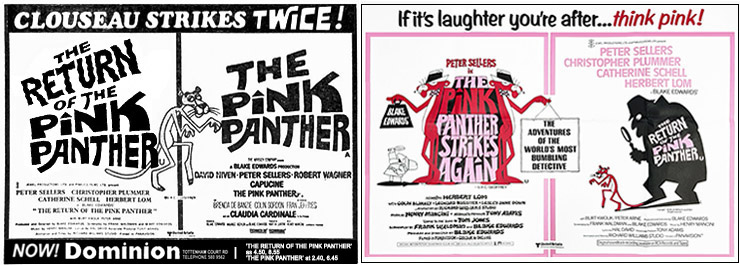 |
||||||||||
|
The double-bill once again proved very popular and The Return Of The Pink Panther was then paired with The Pink Panther Strikes Again. This double-bill did not screen at the London Pavilion as The Spy Who Loved Me was still playing there after transferring from the ODEON Leicester Square. Instead The Pink Panther Strikes Again/The Return Of The Pink Panther played at the 350-seat Ritz cinema in Leicester Square for six weeks from Thursday, December 15, 1977, and then transferred to the 113-seat Scene 2 cinema in the Swiss Centre for a further 13 weeks from Thursday, January 26, 1978. From Thursday August 9, 1979, The Return Of The Pink Panther then played on a double-bill with Revenge Of The Pink Panther this time at the London Pavilion. Finishing its four week engagement at the London Pavilion on Wednesday September 5, 1979 (to be replaced by Moonraker), this was the final double-bill of Peter Sellers Pink Panther films. Within a year its star was dead, although the franchise limped on until director Blake Edwards passed away in 2010. |
||||||||||
 |
||||||||||
|
||||||||||
|
|
||||||||||